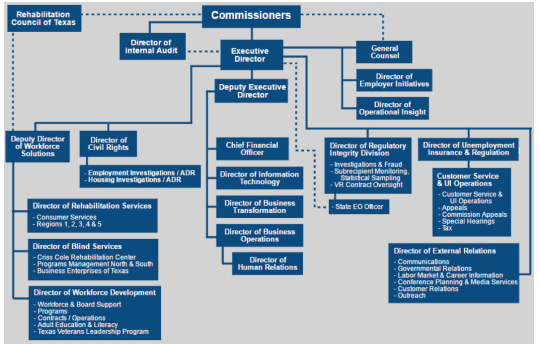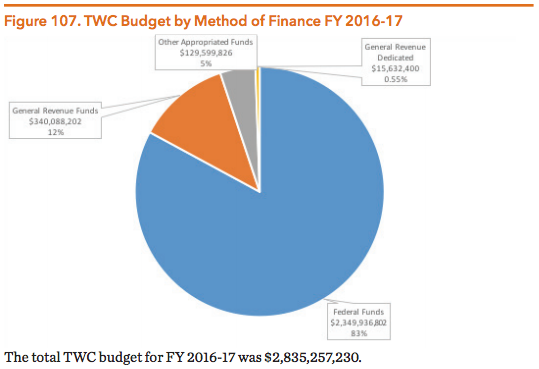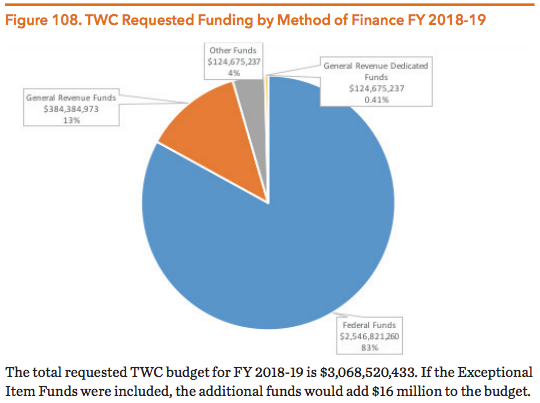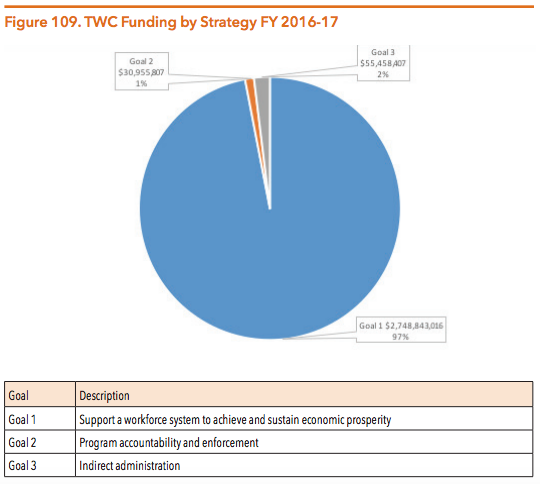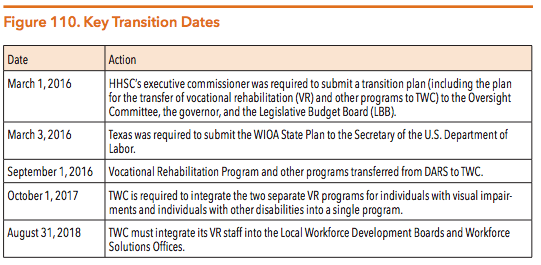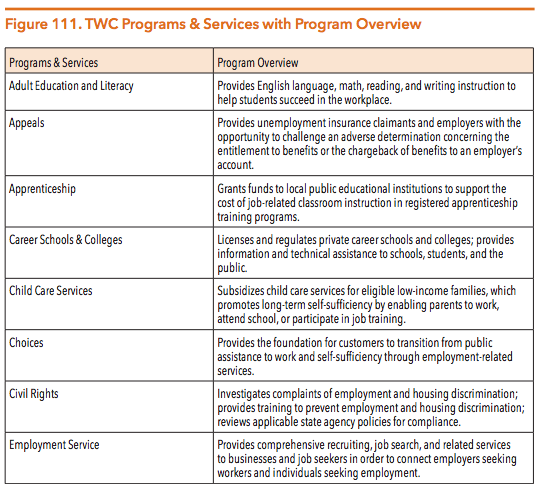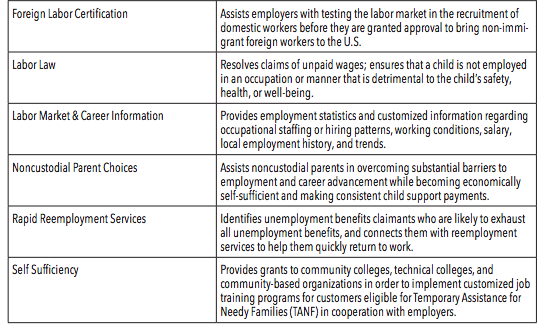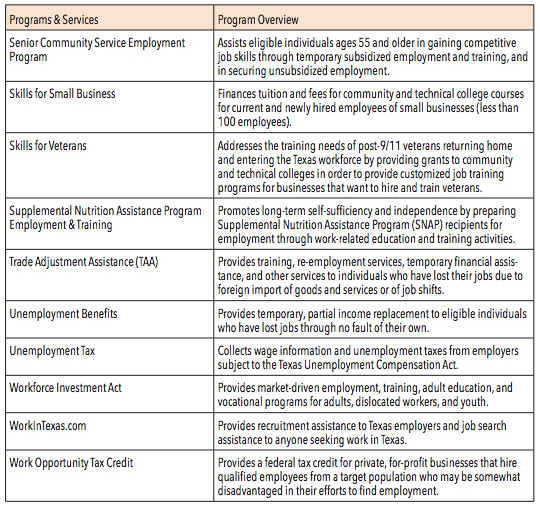POLICY CONCERNS
- Ensuring sustainable employment outcomes for people with serious and persistent mental illness
- Maintaining continuity of services during the transfer of services from DARS to TWC
- Establishing accountability for outcome-based vocational rehabilitation services for individuals living with serious and persistent mental illness
FAST FACTS
- The national unemployment rate was 4.7% in May 2016, down 0.3% from the previous month, according to the Bureau of Labor Statistics. The unemployment rate in Texas was 4.4% in April 2016, up 0.1% from the previous month. The unemployment rate is the ratio of the population that is unemployed and seeking employment to the current labor force.
- The national and state unemployment rates do not always reflect the prevalence of unemployment for people with serious mental illness or intellectual and developmental disabilities (IDD). The National Alliance on Mental Illness (NAMI) reported that the national unemployment rate for individuals receiving public mental health services was approximately 80% in 2012. The same year, the unemployment rate for individuals receiving services through the public mental health system in Texas was 85.6%.
- For individuals with IDD, the national labor force participation rate is 30.5%. The labor force participation rate is the percentage of the population that is either employed or actively seeking work.
- In March 2016, there were 4.3 million people with disabilities (ages 16 to 64) employed in the United States. This group represented 3% of the nation’s total workforce.
ORGANIZATION CHART
Source: Legislative Budget Board. (2016). Legislative Appropriations Request for Fiscal Years 2018 and 2019 – Texas Workforce Commission. Pg. 15.
Texas Workforce Commission
The Texas Workforce Commission (TWC) is the state agency charged with overseeing and providing workforce development services to both employers and job seekers across the state. TWC works toward the end goals of the Governor’s economic development strategy by providing the needed workforce development component.
TWC’s major functions include:
- Developing the workforce;
- Providing support services, including child care, for targeted populations participating in workforce training; and
- Administering the unemployment benefits and tax programs.
TWC is part of Texas Workforce Solutions, a local and statewide network comprised of TWC, 28 Workforce Development Boards, and their contracted service providers and community partners. Workforce Development Boards allow for regional planning and service delivery. Through this network, TWC reaches consumers at the local level in Workforce Solutions offices across the state and five Tele-Centers.
Texas Workforce Solutions provides workforce development services that are intended to: 1) help consumers find and maintain employment, and 2) help employers hire the skilled workers needed to conduct business. Workforce partners include community colleges, adult basic education providers, local independent school districts, economic development groups, private businesses, and other state agencies. Collaboration and coordination across these various stakeholders is necessary to meet TWC’s overall mission to “promote and support a workforce system that creates value and offers employers, individuals, and communities the opportunity to achieve and sustain economic prosperity.”
In FY2015, TWC served nearly 770,000 Texans through programs every year, in addition to over 86,000 employers. Figure 106 describes three major types of beneficiaries who utilize TWC services.
The national unemployment rate was 4.7% in May 2016, down 0.3% from the previous month, according to the Bureau of Labor Statistics. The unemployment rate in Texas was 4.6% in July 2016, up 0.1% from the previous month.
Individuals with disabilities, including serious mental illness, often experience barriers associated with joining and participating fully in the labor force. People with disabilities are more likely to work part time and, on average, earn less than individuals without disabilities at every level of educational attainment. Because of the unique challenges individuals with disabilities face in the job market, national and state-level unemployment rates do not always reflect the prevalence of unemployment for people with serious mental illness or intellectual and developmental disabilities (IDD). The National Alliance on Mental Illness (NAMI) reported that the national unemployment rate for individuals receiving public mental health services was approximately 80% in 2012. The same year, the unemployment rate for individuals receiving services through the public mental health system in Texas was 85.6%. Yet for persons living with serious mental illness, employment can play a primary role in recovery and well-being.
A 2016 report by the Texas Workforce Investment Council stated that based on 2014 data, there were over 3.4 million individuals with disabilities living in Texas, the second largest number per state in the nation. In 2015, the average monthly labor force participation rate for individuals with intellectual and developmental disabilities (IDD) across the country was 30.5%.
Individuals with disabilities, including serious mental illness, can enhance workforce diversity and offer employers unique skill sets and perspectives when integrated into the labor force. Integration of these individuals can contribute to the economic growth of Texas when provided with the appropriate opportunities and supports.
Funding
TWC’s funding is comprised of both federal and state dollars, with the majority of funding coming from federal sources. TWC provides grants, through allocation formulas, to Workforce Development Boards that plan and administer the Workforce Investment Act (WIA), Temporary Assistance for Needy Families (TANF) Choices, Employment Services, Supplemental Nutrition Assistance Program Employment and Training (SNAP E&T), child care, and other workforce and support services. Employer-paid state unemployment taxes and reimbursements pay for state unemployment benefits. The U.S. Department of Labor allocates funds from the Federal Unemployment Tax (FUTA) to the states to pay for administrative and operational costs.
Note that the DARS to TWC transfer of programs moves approximately $309 million in FY 2017 to TWC (82% of which are federal funds).
Source: Legislative Budget Board. (2016). Legislative Appropriations Request for Fiscal Years 2018 and 2019 – Texas Workforce Commission.
Source: Legislative Budget Board. (2016). Legislative Appropriations Request for Fiscal Years 2018 and 2019 – Texas Workforce Commission.
Source: Legislative Budget Board. (2016). Legislative Appropriations Request for Fiscal Years 2018 and 2019 – Texas Workforce Commission.
Changing Environment
Prior to September 2016, TWC did not provide any direct behavioral health treatments or supports to Texans with a mental health condition. However, in 2016, the state transitioned employment-related programs from the Department of Assistive and Rehabilitative Services (DARS) to TWC as part of the HHSC Transformation process. As a result, starting September 1, 2016, TWC began to work directly with individuals with disabilities, including serious mental illness, hearing impairment, substance use disorders, traumatic brain injury, and other physical, developmental, or mental disabilities.
Sunset Highlights
On September 1, 2016, DARS dissolved as a state agency and several of its programs were transferred to TWC. Those programs include:
- The Vocational Rehabilitation program for individuals with visual impairments
- The Criss Cole Rehabilitation Center
- The Vocational Rehabilitation Program for individuals with disabilities
- The Business Enterprises of Texas Program
- The Independent Living Services Program for Older Individuals Who Are Blind
SB 208 (84th, Campbell/Burkett), the TWC “Sunset Bill,” placed all of the state’s programs that are funded through the federal Workforce Innovation and Opportunity Act (WIOA) together under one agency, TWC. Programs within DARS that met that criterion will now be housed in TWC, while all other DARS programs will be transferred to HHSC.
SB 208 also required the DARS commissioner and TWC executive director to join the Health and Human Services Transition Legislative Oversight Committee (created by SB 200, 84th, Nelson/Price) as ex-officio members. Additionally, SB 208 required the executive commissioner of HHSC, the commissioner of DARS, and TWC’s executive director to develop a plan to be submitted to both the Oversight Committee and the governor detailing the transfer of all services and programs to ensure a careful and deliberate transition. The transition plan focused on ensuring the continuity and accountability of the programs being transferred from DARS to TWC and HHSC. SB 208 also required HHSC, DARS, and TWC leaders to include their DARS transition plan within the larger HHS transition plan that was submitted to the Oversight Committee, the governor, and the LBB on March 1, 2016, with a revised version delivered in August 2016. Required by SB 200, the larger HHS transition plan outlines how the state will implement the health and human services consolidation in coming years. More information on SB 200 can be found in the HHSC section of this Guide.
SB 208 identified nine requirements for the transfer of Vocational Rehabilitation (VR) services, including that measures be taken to ensure that unnecessary disruptions of transferred services and programs did not occur and that there be a strategy for exchanging data with other state agencies that refer consumers for VR services. The transfer of the programs from DARS to TWC involved 1,860.9 full-time equivalent employees; a budget of $309 million (82% of which are federal funds), including state and federal funds; and more than 96,000 consumers.
Source: Texas Workforce Commission. (2015). Plan for the Transfer of Vocational Rehabilitation Services and Other Services and Programs.
Programs Transferred from DARS per Sunset Legislation
VOCATIONAL REHABILITATION FOR PERSONS WITH DISABILITIES (VR)
For people with mental illness, work can play a primary role toward their recovery and wellbeing. Benefits of a job for an individual living with mental illness can include a daily routine, financial security, health benefits, social interaction, and a sense of purpose. Individuals with IDD also benefit from employment. Studies of selfreported data show that earnings, productivity, and the quality of social relationships are the main reasons why individuals with IDD maintain employment.
While challenges such as difficulty with particular schedules, medication side effects, and stigma can make it harder for an individual with a disability or serious mental illness to get and keep a job, there are options for support such as flexible work schedules, part-time work, or supported employment. There are programs to help individuals with work readiness and employment success. The Vocational Rehabilitation (VR) program is a state-federal partnership designed to help individuals with disabilities (physical and developmental disabilities as well as serious mental health conditions) prepare for, find, and keep jobs. The VR program is also intended to help individuals with disabilities transition from school to work.
In order to receive VR services, an individual must:
- Be present in the state of Texas;
- Have a physical and/or mental condition that affects the individual’s ability to work;
- Need vocational rehabilitation services in order to help the individual get and/or keep a job; and
- Be able to get and keep a job after receiving services.
If a person already receives Supplemental Security Income (SSI) or Social Security Disability Insurance (SSDI), the individual is presumed eligible for vocational rehabilitation services. Eligibility for VR services does not depend on an individual’s income.
People who are eligible to receive VR services work with a VR counselor to determine what services are appropriate and needed for each case. VR services are consumer-focused, meaning that those who receive services have a voice in an Individualized Plan for Employment (IPE), which consumers create with their VR counselors. An IPE helps outline what employment goals an individual has and how VR services can assist in achieving those goals. VR Services are based on an individual’s needs and vary greatly depending on the disability, needs, and employment goals. Work-related services may include counseling, training, medical treatment, assistive devices, job placement assistance, and other services. Consumers who obtain these vocational rehabilitation services follow six steps in the service delivery process:
- Apply for services
- Undergo an assessment to determine service eligibility
- Develop an Individualized Plan for Employment (IPE) with VR counselors
- Receive training and related services, as needed
- Receive employment assistance services
- Receive post-employment services, as needed
VR service providers partner with businesses to develop new employment opportunities. Program staff also work with public school districts to target students with disabilities who need services to help them transition from secondary education to post-secondary school or work.
More information on the VR program can be found online.
VOCATIONAL REHABILITATION FOR INDIVIDUALS WITH VISUAL IMPAIRMENTS
The Vocational Rehabilitation Program for Individuals with Visual Impairments provides services to eligible individuals who: 1) have a visual impairment that is a barrier to employment, 2) can benefit from VR services to better their employment outcomes, and 3) require VR services to prepare for, get, and retain gainful employment. VR services available to eligible individuals with visual impairments include:
- Assessments
- Rehabilitation teaching
- Counseling, guidance, and referral
- Specialized services for deafblind individuals
The DARS to TWC transition plan states that after September 1, 2016, TWC and HHSC will continue to coordinate the delivery of services to children with blindness or visual impairments. While HHSC now operates the Blind Children’s Program, TWC will closely coordinate with HHSC to ensure that the needs of consumers with blindness or visual impairments are addressed. The transition plan states that there will be specific ongoing efforts to coordinate services for these consumers during the transition of aging out of the Blind Children’s Program in HHSC to VR services in TWC.
INTEGRATING THE VOCATIONAL REHABILITATION PROGRAMS
On September 1, 2016, all VR services transitioned from DARS to TWC. The requested VR programs budget for the FY2018-19 biennium was over $590 million. The VR staff at that time continued providing the same services during the transition. As part of the integration process, TWC used the expertise of the VR staff to develop plans to organize services based on each consumer’s individualized needs and to support specialization of VR counselors serving different client populations.
TWC was further required to integrate the VR Program for Persons with Physical and Mental Disabilities with the VR Program for Individuals with Visual Impairments into a single VR program no later than October 1, 2017.
TWC must facilitate this integration through the following minimum actions:
- Reorganize service delivery to achieve an integrated VR program that meets each consumer’s individual needs;
- Develop a plan to support specialization of VR counselors serving different client populations;
- Redesign performance measures;
- Consolidate policies; and
- Recommend adoption of any necessary rules.
TWC was required to develop a transition plan for the integration of the VR programs no later than September 1, 2016. Before the VR programs transferred to TWC, the VR programs serving the general population and the visually impaired population had different regional boundaries, different regional management structures, different policies for providing consumer services, and different standards for vendors who provide services. During the transition process, DARS and TWC will review program policies and provider standards to identify necessary revisions and associated timelines. The agency must also determine how to realign the regional boundaries of the two programs. This review in FY 2016 was intended to position TWC to make needed policy and standards changes by October 1, 2017, a date mandated by the Texas Legislature. All accepted changes will go into effect on October 1, 2017.
SB 208 required TWC to integrate VR staff into the network of Local Workforce Development Boards and Workforce Solutions Offices by August 31, 2018. TWC will work with each of the 28 Boards to ensure integration is successful.
THE CRISS COLE REHABILITATION CENTER
The Criss Cole Rehabilitation Center (CCRC) is a comprehensive VR training facility that was formerly operated by the DARS Division for Blind Services (DBS). CCRC is an adult residential training facility in Austin named in honor of Judge Criss Cole, who lost his sight while serving as a Marine during World War II. During his time as a member of the Texas House of Representatives and the Texas Senate, Judge Cole was a strong advocate for providing access to services for people with disabilities.
Today, CCRC works with consumers who are blind to help them achieve employment and independent living goals. Residents at CCRC receive training in core skills such as orientation and mobility, Braille, daily living, career development, and assistive technology. CCRC’s ultimate goal is to empower consumers to fully participate in their employment, community, and society.
THE BUSINESS ENTERPRISES OF TEXAS PROGRAM
The Business Enterprises of Texas (BET) program is a federally-sponsored, stateadministered program that provides food management opportunities to Texans who are blind. BET collaborates with the Vocational Rehabilitation Program for Individuals with Visual Impairments to identify individuals who may be ideal participants in this program and who are interested in food service and vending management training and employment. People who are selected to join the BET program become licensed BET managers and earn their personal income from profits produced by their businesses which are located on state and federal properties. In 2015, businesses managed by BET managers produced more than $65 million in annual sales. The same year, BET employed over 1,400 Texans in its food service and vending facilities.
On September 1, 2016, the BET program transitioned from DARS to TWC. The program continues to operate as it was structured before the transition. TWC is currently undergoing a review of the BET program rules and program structure in the FY2016-17 biennium to identify any opportunities for improved operational efficiency. The BET Trust Fund, which provides benefits to managers in the program, will continue to operate as it currently does.
INDEPENDENT LIVING SERVICES PROGRAM FOR OLDER INDIVIDUALS WHO ARE BLIND
The Independent Living Services Program for Older Individuals Who Are Blind provides services to help eligible individuals avoid institutionalization and live independently in their own homes and communities. Although TWC will continue to receive grant funding and be responsible for program oversight, the agency will enter into an interagency contract with the HHSC who will administer these services. TWC will work closely with HHSC and its administration of additional independent living programs.
Overview of Texas Workforce Commission (TWC) Programs
SKILLS DEVELOPMENT
TWC’s Skills Development program provides grants, also called Skills Development Funds, to community and technical colleges in order to provide customized job training programs for businesses who want to train new workers or upgrade the skills of their existing workforce. Successful outcomes of the program are achieved through collaborations between TWC, local businesses, public community and technical colleges, workforce development boards, and economic development partners. In FY 2014, TWC:
- Awarded 63 Skills Development Fund Grants totaling $36 million;
- Served 103 Texas businesses;
- Supported the creation of 5,779 new jobs; and
- Upgraded the skills of 10,003 workers in existing jobs.
Examples of past grant projects include:
- CoServ Inc. partnered with TWC and North Central Texas College for a $161,845 grant that trained 143 employees within the electrical industry.
- Osteogenics Biomedical partnered with TWC and South Plains College for a $60,757 grant that trained 18 small business employees to become compliant with health care regulations.
- Texas Hydraulics partnered with TWC and Temple College for a $399,254 grant that trained 400 welders, mechanists, and engineers to increase the number of certified workers.
The Skills Development program is funded entirely by appropriations from the Texas Legislature.
VETERANS SPECIFIC SERVICES
TWC provides services to veterans living in Texas, as well as more indirect support through specific rules, policies, guidance, and initiatives. Veterans are given priority within the TWC service delivery system, meaning that while many services are the same as those provided to non-military civilians, veterans receive priority service at all Workforce Solutions offices. Many of the TWC Workforce Solutions offices across the state have veterans representatives, who specialize in assisting veterans with employment-related needs. In FY 2015, TWC and Workforce Solutions offices provided over 112,000 veterans with services such as job search assistance, training, and other transition assistance.
Examples of TWC’s veteran-specific services include the Texas Veterans Leadership Program and the College Credit for Heroes. The Texas Veterans Leadership Program is a resource and referral network connecting veterans of Iraq and Afghanistan to a veterans resource and referral specialist in each of the 28 workforce development areas. College Credit for Heroes is a program that allows veterans to receive classroom credit for their military experience through certain colleges.
OTHER TWC PROGRAMS
Source: Texas Workforce Commission. (n.d.) Programs and Services.
NEXT SECTION: TEXAS DEPARTMENT OF CRIMINAL JUSTICE AND LOCAL CRIMINAL JUSTICE AGENCIES
DOWNLOAD A PDF OF THE FULL GUIDE
